Nikon AF-S Nikkor 50mm 1: 1.4G SWM (abbreviated Nikon 50 / 1.4G) is one of Nikon's fastest autofocus lenses. It's classic half a ruble (a lens with a focal length of 50 mm), which is suitable for a huge number of photo tasks, in particular, such a lens can be shot in low light, used as a standard fixed lens on Nikon FX cameras, the lens is suitable for portrait and artistic shooting. With huge aperture F / 1.4 you can create and enjoy the result.
All Nikon 50-58 / 1.4 / 1.2 autofocus lenses
- Nikon 50mm 1: 1.4 AF Nikkor (first version, MK I) - the lens was produced only in Japan from 1986 to 1991
- Nikon 50mm 1: 1.4 AF Nikkor (second version, MK II, also known as the 'N', or the 'NEW' version) - the lens was only available in Japan from 1991 to 1995
- Nikon 50mm 1: 1.4D AF Nikkor (third version, MKIIIbetter known as 'D'-version) - the lens is available from 1995 to this day. There are two subversions that are no different.
- Nikon 50mm 1: 1.4G AF-S Nikkor SWM (fourth version, MKIVbetter known as 'G' version) - the lens is only available in China from 2008 to this day.
- Nikon N AF-S Nikkor 58mm 1: 1.4G Nano Crystal Coat SWM Aspherical (version better known as'58/1.4') - the lens is only available in Japan from 2013 to this day.
- Nikon Nikkor Z 58mm 1: 0.95 S Noct - The lens is available from 2019 to this day. Premium Lens for Mirrorless Cameras Nikon Z... It does not have automatic focus, but has a record aperture. Complex optical design with 17 elements in 10 groups, with 4 ED elements and 3 aspherical elements.
- Nikon Nikkor Z 50 / 1.2 S - The lens has been produced from 2020 to the present day. Professional S-line lens for mirrorless cameras Nikon Z... Complex optical design with 17 elements in 15 groups, with 2 ED elements and 3 aspherical elements
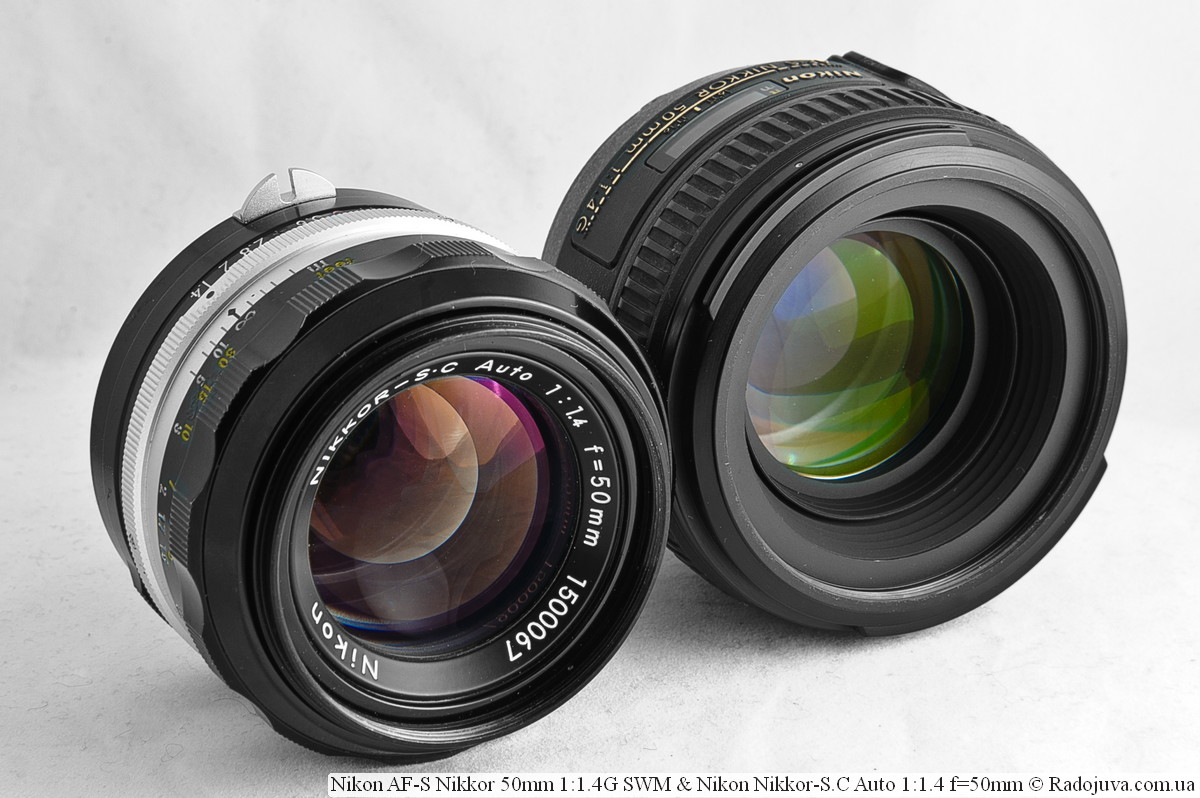
Nikon Nikkor-SC Auto 1: 1.4 f = 50mm and Nikon AF-S Nikkor 50mm 1: 1.4G SWM
Main technical characteristics of Nikon AF-S Nikkor 50mm 1: 1.4G SWM:
| Review Instance Name | Nikon AF-S Nikkor 50mm 1: 1.4G SWM 309536 |
| Basic properties |
|
| Front Filter Diameter | 58 mm, plastic thread for filters |
| Focal length | 50 mm, EGF for Nikon DX cameras is 75 mm, EGF for Nikon CX cameras is 135 mm |
| Zoom ratio | 1 X (this is a fixed lens, it does not have a zoom) |
| Designed by | for digital and film cameras |
| Number of aperture blades | 9 pieces, petals rounded |
| Tags | focusing distance in meters and feet, depth of field tags for F / 11 and F / 16 values, bayonet mount tag and lens hood attachment / fixation |
| Diaphragm | F / 1.4 to F / 16, without aperture ring. |
| MDF | 0.45 m, maximum magnification ratio 1: 6.7 |
| The weight | 280 g |
| Optical design | 8 elements in 7 groups. The lens does not use special optical elements in its design.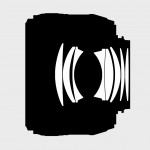 The image of the circuit is clickable. The image of the circuit is clickable. |
| Lens hood | Replaceable Nikon HB-47 plastic lens hood, lenses use the same lens hood Nikon AF-S Nikkor 50mm 1: 1.8G SWM Aspherical and Nikon AF-S Nikkor 50mm 1: 1.8G SWM Aspherical Special Edition |
| Manufacturer country | MADE IN CHINA |
| Period | From September 2008 -> |
| Instruction | View -> |
| Price |
The Nikon 50 / 1.4G lens will work great on any Nikon DSLR camera. Among fifty brothersthis Nikon 50 / 1.4G is the best. At one time, he became a replacement for his older brother Nikon 50mm f / 1.4D AF Nikkor... In fact, the Nikon 50 / 1.4G was introduced back in 2008, and I think that soon we will see a fifty-kopeck piece (50mm lens) from Nikon with more serious performance.
Addition: my prediction came true, and in addition to the 'non-professional' Nikon 50 / 1.4G Nikon has released a 'professional' about fifty kopecks Nikon N AF-S Nikkor 58mm 1: 1.4G SWM... Still, it's a shame that Nikon doesn't have professional fifty dollars. At the same time, Canon has two of them - Canon Lens EF 50mm 1: 1.2 L USM and Canon Lens EF 50mm 1: 1.0 L USM.
Focus on Nikon 50 / 1.4G
The Nikon 50 / 1.4G lens will focus on any modern DSLR camera. If you found your camera in genealogy nameplatethen you can rest assured that the Nikon 50 / 1.4G will work great with it. The Nikon 50 / 1.4G has a built-in focusing motor, as indicated by the AF-S designation. When focusing, the lens practically does not make noise, a special Nikon SWM (Silent Wave Motor) ultrasonic motor helps it. After two years of using my Nikon 50mm 1: 1.8D AF Nikkor (MKIII)which makes a lot of noise when focusing, using the new Nikon 50 / 1.4G is a pleasure.
When focusing, the front lens group moves in the middle of the frame of the housing. I can’t say that the lens has internal focus. But when focusing, the lens does not change its size, and the filter is wound on a fixed external part of the lens, which does not rotate when focusing. This type of focusing can also be found in Nikon 50mm f / 1.8G AF-S Nikkor. The minimum focusing distance is 45cm.
In focus mode 'M / A'Automatic focusing with manual focus priority is available. This means that in autofocus mode, the focus can be manually adjusted immediately. The 'M / A' mode is very useful, for example for creating focus trap effect... In 'M' mode, only manual focus is available. The focusing ring is rubberized.
Focus Speed
Nikon 50 / 1.4G one of the lowest fokiroki speeds among all fifty dollars Nikon Nikkor. Focus speed is average. The rest fifty kopecks Nikkon Nikkor, even the oldest Nikon 50mm 1: 1.8 AF Nikkor MKIoutperform the focusing speed of the Nikon 50mm F1.4G. Of course, to say that a low speed will not be right, but I would like a faster reaction of the lens for that kind of money.
Attention! Very often they write that the lens is very fast. This term is applied not so much to the focusing speed, but more to the description of the lens aperture at which shutter is very fast, decreasing the shutter speed. The confusion came from the English Fast Lens (fast "fast" lens).
The focus ring is rubberized, in the active position it rotates as much as 180 degrees. Due to the fact that the lens is quite chubby, such a move of the focusing ring is quite enough for comfortable work with manual focusing. During auto focus, the ring remains stationary. In manual focus mode, when the ring reaches its extreme positions, it does not rest, but continues to rotate, slipping, like on many native Nikon lenses.
There is a window on the lens with a scale for focusing distances and a depth of field scale. My Nikon 50mm F1.4G misses focus very rarely, even on F1.4.
Iris control
The lens does not have an aperture control ring, since it is a G-type lens. This fifty dollars is very large aperture F / 1.4, this allows you to achieve a very small depth of field, reduce shutter speed and without raising ISO. This lens is very simple take off... The lens has a 9-blade diaphragm, which is a good indicator. The petals are rounded and give a nice smooth bokeh without nuts or other artifacts.
Compatible with FX and DX cameras
The lens will work perfectly on Nikon FX full-frame cameras. On Nikon DX cameras, due to crop factor, EGF lens will be 75mm. This allows the Nikon AF-S 50mm F/1.4G to be used as a portrait lens on DX cameras without any problems. Rumor has it that Nikon AF-S 50mm F / 1.4G is the best portrait lens for crop, I personally like mine much more for crop portrait Nikon 85mm F / 1.8D AF Nikkor.
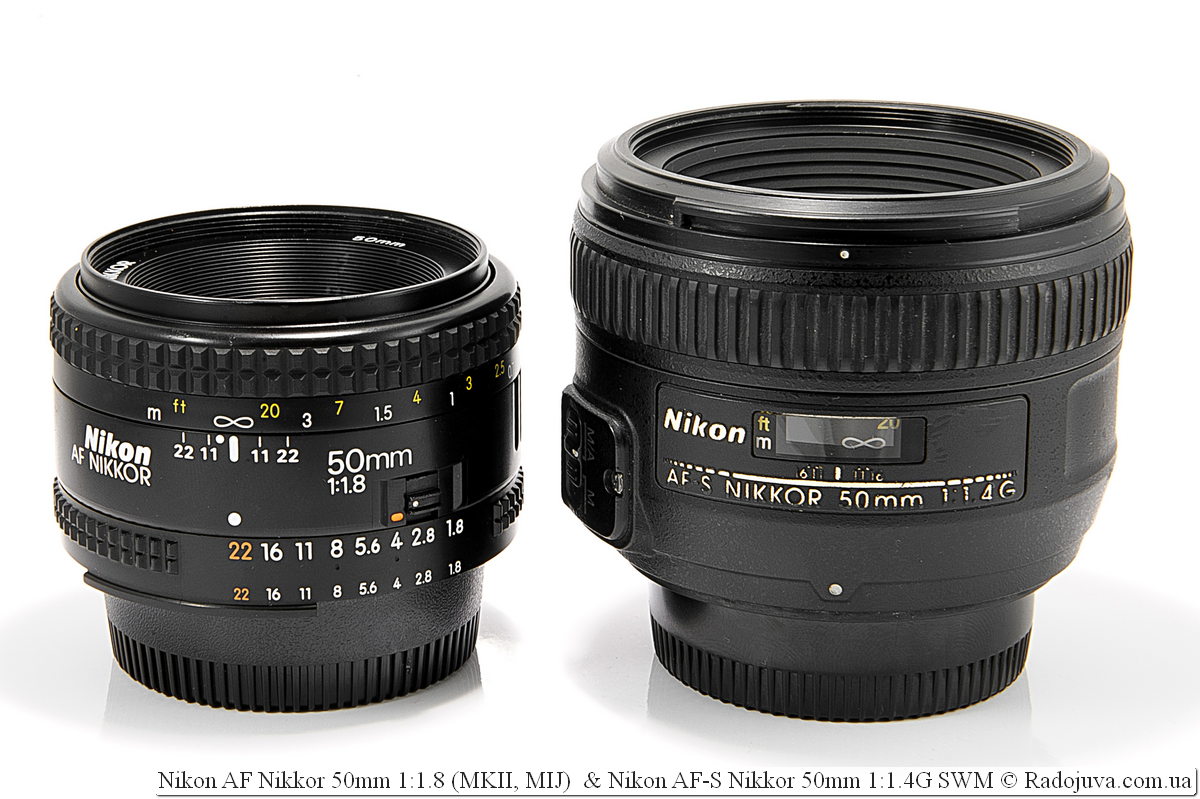
Nikon AF Nikkor 50mm 1: 1.8 (MKII, MIJ version) and Nikon Nikkor 50mm f / 1.4g
Diameter of filter and hood
The lens has a filter diameter of 58 mm. The lens comes with a wonderful hood and pouch bag. The hood can be installed backwards, in this position it is easy to carry on the lens and the hood does not take up extra space in the case.
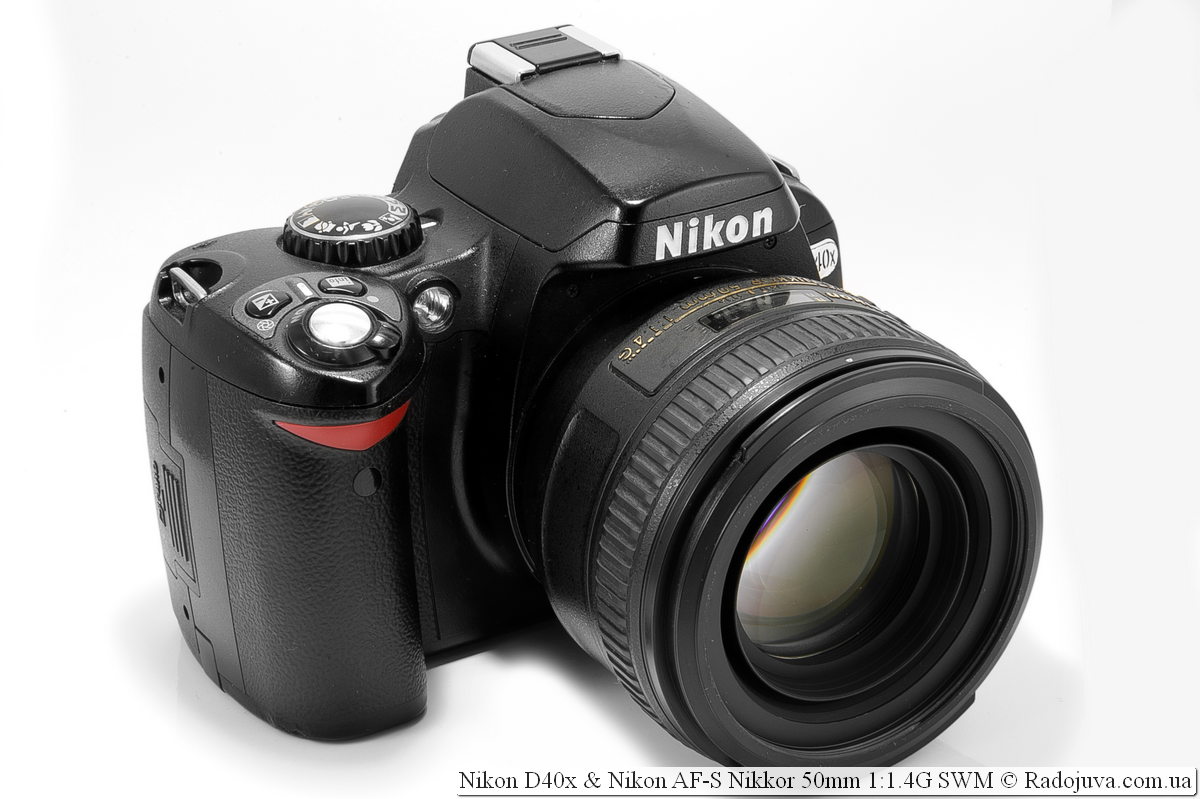
Nikon Nikkor 50mm f / 1.4g on camera Nikon D40x
Nikon 50mm F1.4G Image Quality
The lens, as expected, showed an excellent picture and optical characteristics. The main problem of the Nikon 50mm F1.4G is HA on apertures F1.4-F2.0. The most interesting thing is that HA disappear already at F2.0 - which is a very good indicator. Units have a fully working aperture of F2.0, for example Nikon 50mm F1.2 MF. The lens produces the best image quality at apertures within F2.0-F8.0. Up to F2.0, the lens is inherent HA. After F8.0, diffraction takes effect. About the sharpness: Nikon 50mm F1.4G on F1.4 gives the image is already quite sharp, due to aberrations there is a light software effect. On F1.4, you can make high-quality portraits where strong sharpness of the lens is not always a necessity. Lens gives slightly warm image. The lens provides good contrast. On my cropped camera, vignetting disappears already at F2.8, on F1.4 the vignetting is slightly noticeable. I do not bother with vignetting, it is easy to fix it in the editor. The lens normally tolerates side and back light. A strong drawback in the image of a lens of this class is a slight barrel-shaped distortion (distorting the geometry of the image). Many fifty dollars have much less distortion or do not have it at all. On crop, distortion is barely noticeable. The bokeh of the lens deserves special attention. The lens gives a very nice, even bokeh. Even on closed apertures, discs in the blur zone have a regular round shape. Very funny, but on F1.4, the discs in the blur zone are oval and create twisted bokeh. Generally: high image quality.
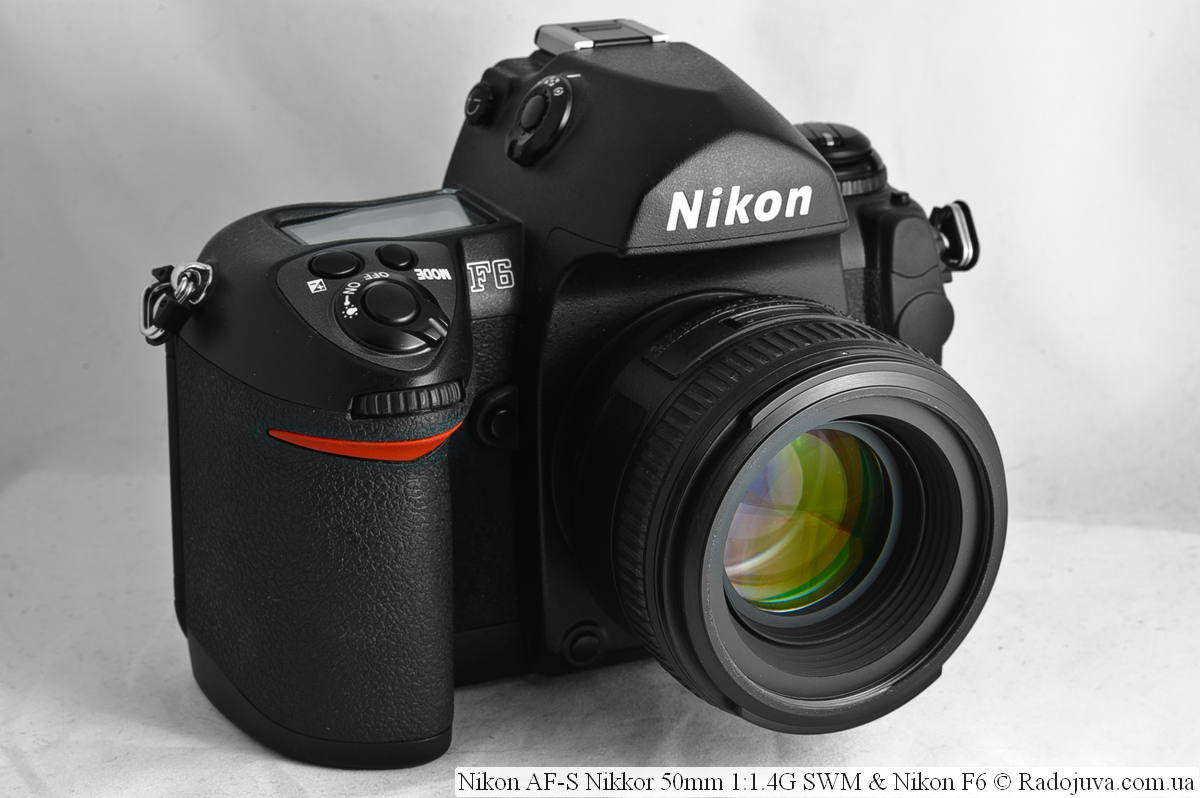
Nikon AF-S Nikkor 50mm 1: 1.4G SWM on a film TOP camera Nikon F6
Sample Photos on Nikon D40 (APS-C, DX)
All photos in the gallery below were taken on Nikon D40. I specifically filmed on Nikon D40to show that even on the simplest DSLR, the lens Nikon 50mm F1.4G works great and with it you can achieve a good result.
Sample Photos on Nikon D80 (APS-C, DX)
All photos in the gallery below were taken on Nikon D80. All photos without treatment... RAW -> JPEG Q80%. Reduced size to 1600 * 1200 and printed data from EXIF.
Sample Photos on Nikon D3200 (APS-C, DX)
All photos in the gallery below were taken on Nikon D3200. All photos without treatment... RAW -> JPEG Q80%. Reduced size to 1600 * 1200 and printed data from EXIF.
RAW source files ('.NEF') can be download from this link (28 files, 350 MB).
More examples of photos can be found on my blog here и here.
Personal experience using
I have a lens Nikon 50mm F1.4G I liked it with my picture (image quality). I often work with optics that only support manual focusing, because the average focusing speed is Nikon 50mm F1.4G for me it doesn’t matter at all. The lens in the hands is quite weighty, but its outer plastic part is felt. And the inscription Made in China is not very credible. I used two years with a tail Nikon 50mm f / 1.8D AF Nikkor after which I switched to Nikon AF-S 50mm 1: 1.4G and I have no regrets about it. In general, if you need a fix after a whale lens, then Nikon 50mm f / 1.8D AF Nikkor or Nikon 50mm f / 1.8G AF-S Nikkor will be the best option. Usually aperture F / 1.4 is rarely required and is quite difficult to work with. F / 1.4 is often taken by professionals who know exactly what they need. My copy was out of order in a light collision from the limousine seat. The focusing motor broke down, the repair cost $ 150, after 3 months the motor broke down again during a long shooting on one of the frames. I sold this lens after repairs. A year later, I bought a new one, then sold it again. Then I bought the same lens again. But somehow this lens did not take root for me.
You can read more information about other autofocus fifty dollars here... In addition, there is also an analogue of Nikon AF-S 50mm 1: 1.4G from a third-party manufacturer - Sigma 50mm 1: 1.4 DG HSM EX.
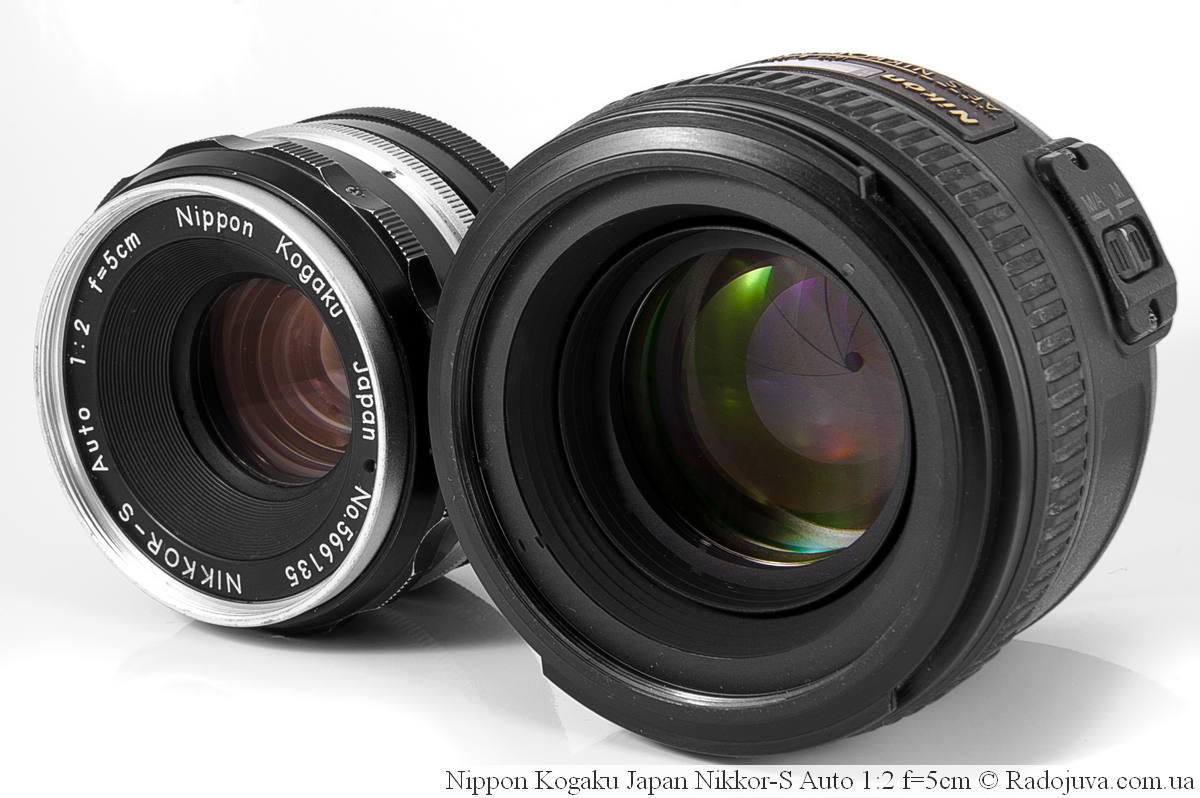
The oldest mirrored fifty dollar - Nippon Kogaku Japan Nikkor-S Auto 1: 2 f = 5cm and TOP Nikon AF-S Nikkor 50mm 1: 1.4G SWM
You can see the real prices for the lens in online stores here, or in the price block below:
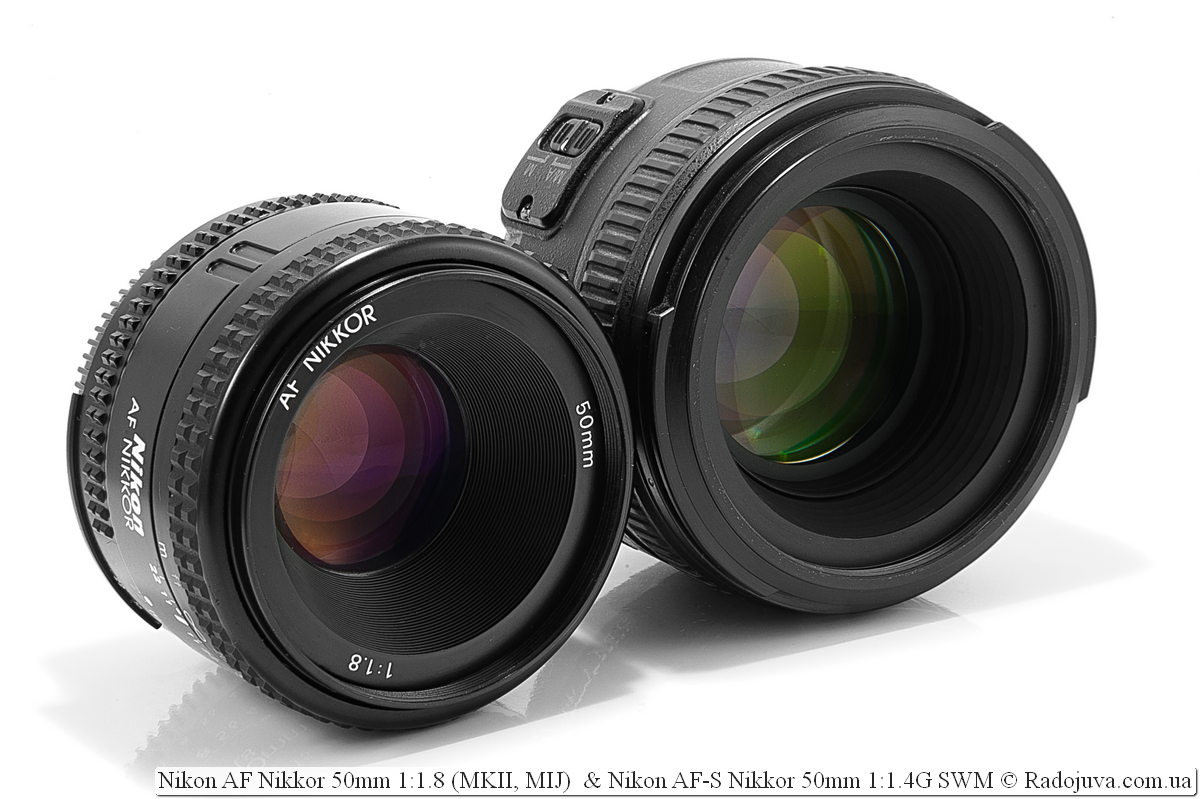
Nikon AF Nikkor 50mm 1: 1.8 (MKII, MIJ version) and Nikon Nikkor 50mm f / 1.4g
Comments on this post do not require registration. Anyone can leave a comment. Many different photographic equipment can be found on AliExpress.
Video review
You can watch the video review here (on my new YouTube channel) or in the box below. Many thanks to Vladimir Morgunov for helping create the video review.
Conclusions:
Nikon 50mm F1.4G - a wonderful lens. Has few shortcomings. It is the best Nikon Nikkor fifty. Recommend.
Material prepared Arkady Shapoval. Training/Consultations | Youtube | Facebook | Instagram | Twitter | Telegram

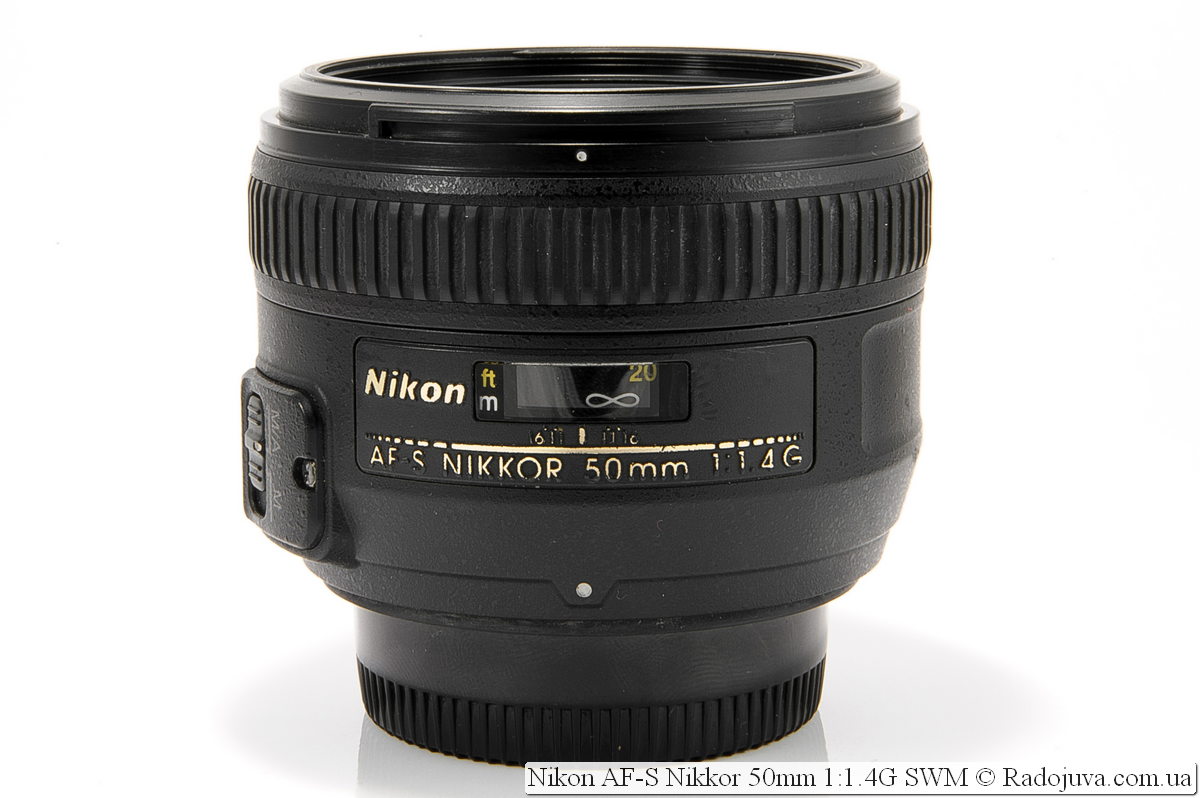
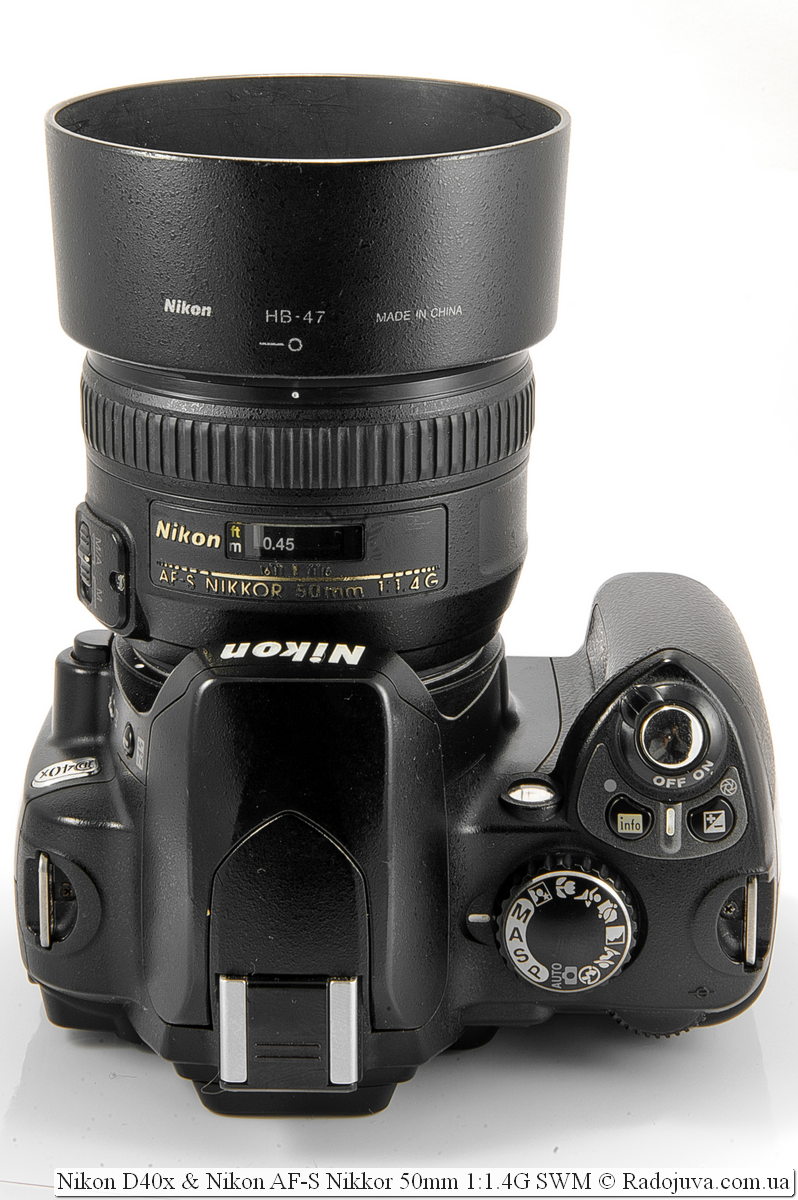
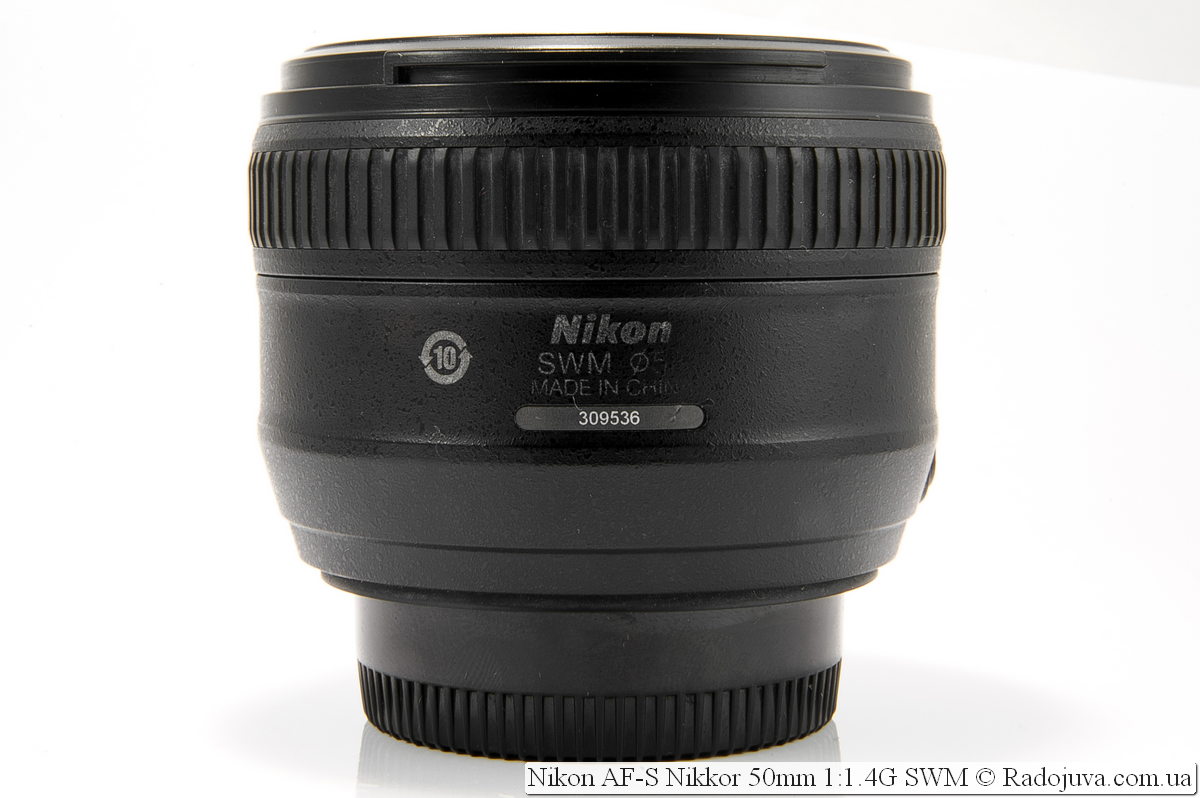
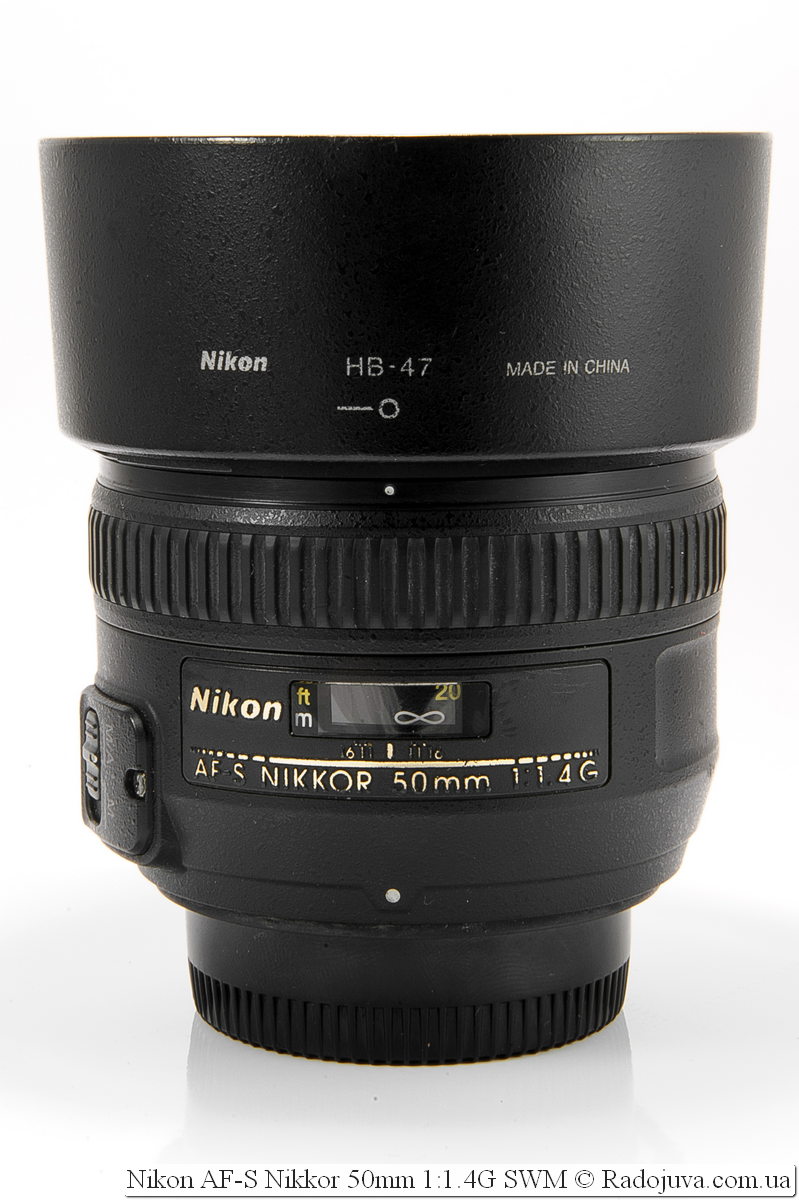
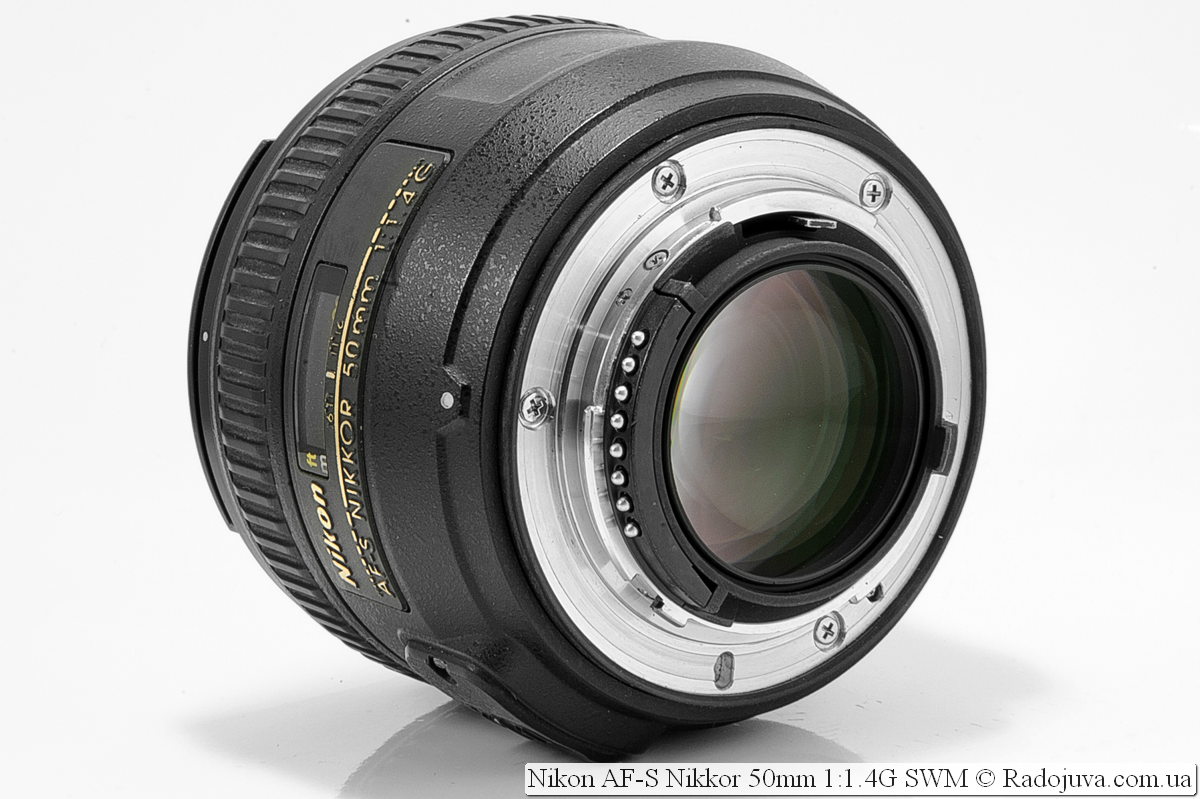
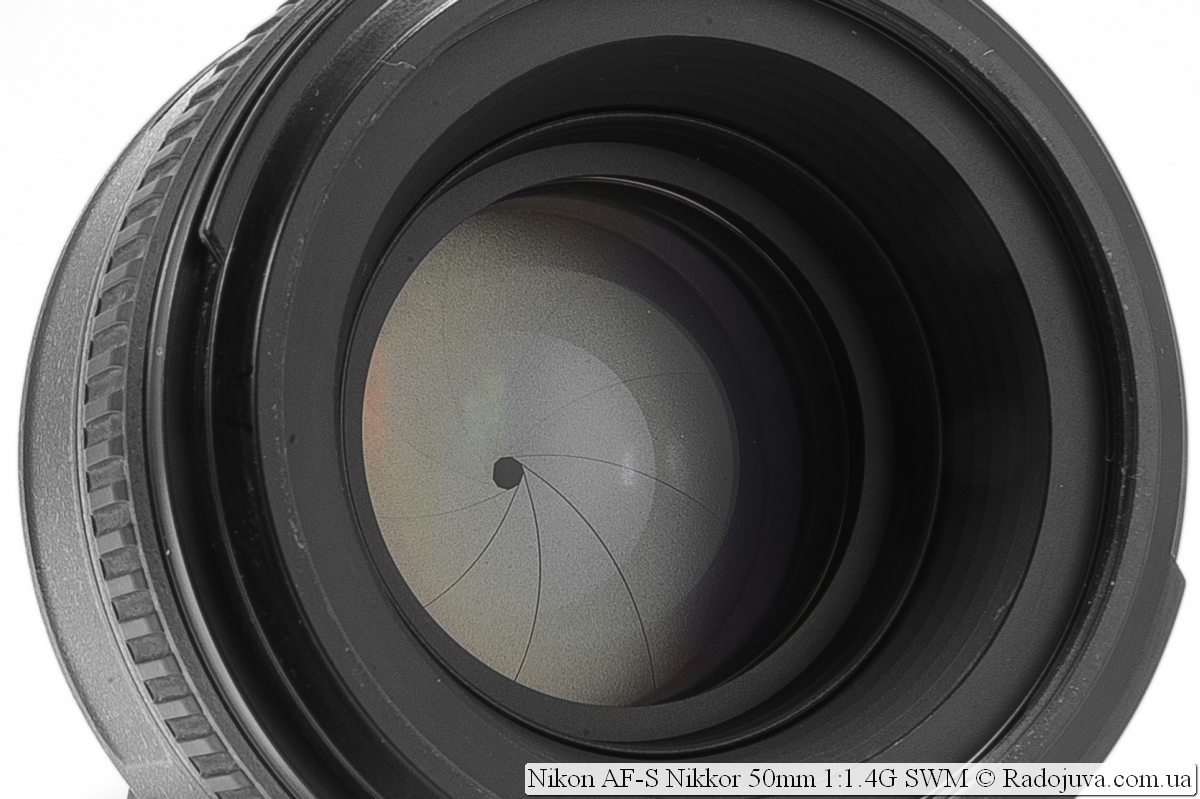
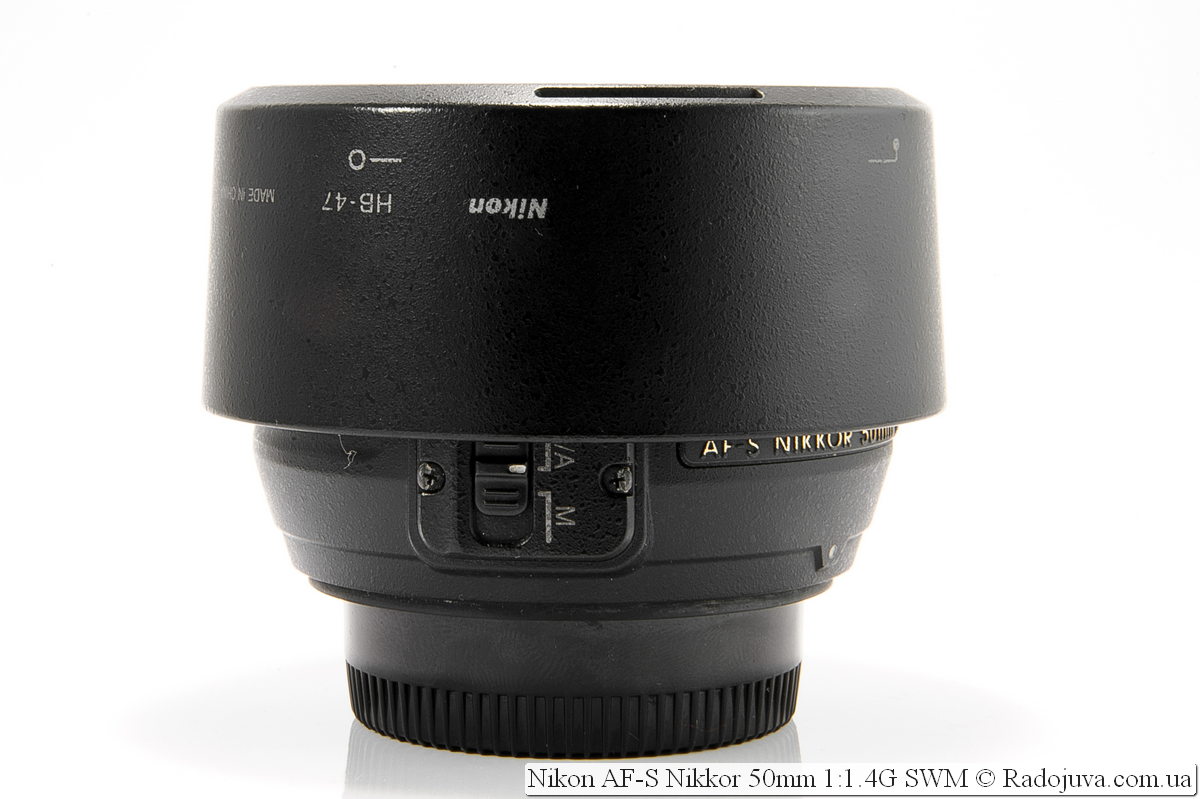


































































Good time of the day! I have a question, or rather I cannot make a choice. camera 5100, I don’t make a photo and I don’t plan yet ... I want to buy a fix and puff (made of glass 18-55 and helius 44 (I overcame infinity) but tired of twisting it with my hand) the funds are limited, so the choice 50 1,4G + sb700 or 50 1.8g + sb910.
A good choice.
so even so what is better top puff top poltinik?
My advice: 50 1,4G + sb700
Good afternoon, I bought a Nikkor 50mm f / 1.4G for my D7000. When aiming at the eyes of the person being photographed, the ears are sharp (from a distance of about 2 m). I had to fine-tune the focus for the lens (on the camera): the saved value was “-20 ″ (tested both according to tables and in real conditions, from -1 to -20 I went through step by step and slowly), the default value was 0 (did not change ). After that, autofocus falls more or less, but the result is far from ideal - the eyes are not quite sharp (at or even below 18-105). By the way, for the whale 18-105 I had to set the saved value “-10 ″ (the pictures are sharp, the autofocus is almost Is it normal if you have to resort to boundary (-50) focusing corrections for normal focusing of Nikkor 1,4 mm f20 G? And does focus fine-tuning affect Live View targeting? Thank you in advance for your answer!
If at -20 Everything suits, then it's normal. Both the lens and the camera are responsible for the back focus. In Live View, another focusing principle, there she is not mistaken.
Tell me, I bought a lens not so long ago, I really like it, but I can’t understand what to do, it shoots perfectly in the shade, and if the sun hits, then everything lights up. I can not figure out the reason. and yet, somehow it’s not very successful so far, that there would be clearly several people, for example, 2 clear frames, and the background is blurred. I'm more interested in the first question, tell me the reason if you can. And in general, how to shoot them in sunny weather, so that there would be no glare ????? Who needs it, I can send and show how the background lights up, I would like to understand the reason
If there are overexposures, the exposure is most likely incorrect. Try lowering your ISO and closing your aperture. For a few people to be sharp, you also need to close the aperture, for example, to F5.6
The hood helps in situations like this ...
Good evening, Arkady I’m going to shoot weddings, I need something for a portrait, I’m facing a difficult problem, or 50 1,4G or 50 1,4 D the fact is that I have Nikon D-90 and I looked at the overview between these two lenses http://www.livejournal.com -Nikkor 50mm f / 1.4 - an old friend better than two new ones? Choosing fifty dollars! Testing fifty rubles!
—It's not a question, the difference is 150 bucks, and the picture is 50 1,4D soul, it really pleases more what do you say to that?
I have seen this review many times. I have already answered you.
http://farm5.static.flickr.com/4062/4395132747_51405754cf_o.jpg
I will say that because of the warmer 1.4G picture, I use it, although there is a catastrophic lack of autofocus speed on the G version at weddings.
From left D to right G
You read the review though I can’t give the link correctly I just don’t know how and what to say
I have already answered you.
http://farm5.static.flickr.com/4019/4395900362_bb19ee1ce1_o.jpg
I think the bride you will be shooting will be very interested in these bolts :) Especially the cold picture of the D version :)
and here is the detail of D above, he is again from the left
There are pluses both here and there, but note that the Trust of 1995, and W 2008, the difference is greater than 10 years.
everything is clear, thanks for the good advice, thanks to you, I will probably conclude in the direction of G, how did Nikon d-40 sell his? I think that in a pair of 50 1,4 G would not be a bad couple for portraits?
Yes, not bad. I have examples on the D40 in this review.
Hello! :)) Can you please tell me how to use autofocusing with a 50 mm 1.4 f lens? :) When the aperture is open, in nature, a blurred and sometimes blown out image of a person in the foreground is obtained, and the background is clear. You have to turn the focusing ring ... Maybe you need to increase the aperture? I have a Nikon D90 :) Thanks in advance, I look forward to hearing)
The focus is the same as on any other lens. Working on aperture 1.4 is very difficult. More details in the focus section.
Hello!!! Help with practical advice :) Recently I bought a 50 / 1,4 G lens, everyone is happy, only one SHARPNESS upsets. I’m shooting small crumbs that will not sit quietly in front of the camera. A large number of defective pictures. Maybe I'm doing something wrong? Of course, not all pictures are defective, there are also with crystal sharpness, but I would like more. If you move a little further from the baby, the whole picture is corrupted. Help!!!!!
You need to learn how to handle the lens. Focusing and taking sharp shots on 1.4 is not always easy.
Arkady, thanks for the quick reply, but you can in more detail. Which focus mode should be set for shooting children, which focus point to choose, and which wide or normal zone to choose. And how far can you move away from the model to get clear pictures, and apparently it is worth changing the aperture value? I’m just worried that the object is not defective. And how can I check it for quality ??? On serviceability ????
If there are sharp pictures, then everything is okay with the lens. On the Internet, it’s not difficult to find tests for back and front focus. There are no universal modes, and you will have to choose the modes and focus points yourself, exactly those that will be needed for your picture. I advise you to familiarize yourself with the material from the focus section.
Yes, Arkady I was already familiar with your article. Very helpful information. And I am glad that there are still sharp pictures. So the whole thing is in approach and knowledge. Thanks a lot. :)
Arkady, the same question))) 50 1.4 D or G? I have a D7000. Thanks in advance for your reply.
This question has already been discussed here in the comments. We came to the conclusion for the G version as a warmer one.
Thank you)
Help understand !! if on the lens it writes DX in conjunction with the D7000, then 50mm is 50mm or is it even multiplied by a crop of 1,5 and becomes 75 ?? exactly the same with 35 HH ?? or only those objective lenses that go to ff are multiplied ??? thanks in advance!!!!
To calculate EGF when used at all DH cameras need to multiply by crop factor for all lenses.
Arkady hello! Please tell me, is the Nikon 50mm f / 1.4G AF-S Nikkor lens suitable for the Nikon D40 camera ??? Many thanks!
Yes, it does. In order to find the answer, it was enough to read the review, in which some of the pictures were taken specifically for this camera.
Thank you very much for the answer!)
I saw here a sign with all Nikon cameras and an idea occurred to me, but should I even change the camera! Since the Nikon D40 was created for amateur filming, it is old, out of production, and I already want something more high-quality and professional! To be honest, I don’t like my Nikon D40 at all in quality, it doesn’t shoot well in artificial lighting, without a flash, photos cannot be taken in motion, no tank. The lens to it is my whale 18-55mm.
My eyes fell on the Nikon D90 with an 18-105mm lens. PLEASE tell me what you think of this camera ??? What camera of their category “amateur advanced” within the range of 900-1000 $, together with a lens, could you advise me? I am interested in: sharpness, aperture (to clearly shoot in a poorly lit room), saturation, brightness of the picture, beautiful blurry bokeh when shooting portraits.
I look forward to your advice !!! Thanks again !!! :)
Bokeh is most dependent on the lens. In the review about Nikon D90 everything is written that I think about it. I advise Nikon D7000 and https://radojuva.com.ua/2011/03/obzor-nikkor-af-s-35mm-f1-8-dx/
Nikon D7000 is certainly cool, but I can not afford it. Is the Nikor 18-105mm a good lens? I like that it has a large zoom. Which whale lens is the best for the Nikon D90? What will you advice me?
Coming from the fact that there are only a few whale lenses, the best is 18-200. You can read about 18-105 yourself https://radojuva.com.ua/2010/12/obzor-nikon-18-105-otzuv-nikkor/
Sorry for disturbing. Or maybe there is an analogy to the Canon Nikon D90, but a newer model. The price with the lens is still the same no more than $ 1000
Tell me, because in fotik the quality of the picture depends on the lens? Can I still leave my D40 for a while and buy a good fast lens that is discussed on this page?)) After all, is this lens suitable for all Nikon cases? God, I don’t know what to do !!!!!
A good lens is also very important. I would take a better lens.
Arkady, thank you very much for your advice !!! I see I will do so, and a little later I will buy a new case))
All the best to you!
Please tell me, I have a Nikon D7000 + 16-85 AF-S. I want an objective for weddings and celebrations, like 50 / 1.4 F
Please tell me, I have a Nikon D7000 + 16-85 AF-S. I want an objective for weddings and celebrations, like 50 / 1.4 F
Good fast fix. I myself shoot them at weddings.
Please tell me for what purposes the fixed 35mm and 50mm I have d7000. and is it worth taking both. I would decide what suits me best. Thank you
These lenses have very huge possibilities and the range of purposes where they can be used is very large. There are examples of photos in their reviews, so you can use them to make a general picture of the capabilities of the lenses.
I am the owner of the F version of this masterpiece f 1,4. I shoot on the D5100, and nevertheless it kills a weak focus, which strives to slide down or where else. Or you can get the effect of movement. And it happens even worse that the whole object is slightly out of focus. I use a shutter speed of 1/125, aperture of 2,8, and nevertheless, in the presence of a contrasting object, a bright jacket, a bright wall, the focus goes to the contrasting wall. As a result, a shot in the firebox. What pill can heal this diagnosis? Dumbbells and pushups? In the camera, I changed everything to focus on a point, that is, I must both measure on a point and focus. Also, as far as I know, in ff, it will have a wider depth of field, and in general, will it either change? If I switch to ff, for example d600. Or what advice would you give me?
Conversely, for the same frame (the same framing), the DOF will be less on the FF, since you will need to come closer and unscrew the focus towards the MDF. I don’t know how to treat, I also often lose focus, you just get used to it, if the focusing speed was the same as in the D version, then the lens would be golden.
On the bill, come closer, it’s understandable. Somehow I initially orientated that I would take it, then as I dare, so I will switch to FF. As far as I remember the story, how many decades on the film was shot exactly at fifty dollars, and how many masterpieces, this bug was originally tormented. Tell me which resource tell me where I can look at the work from this masterpiece on the FF, but more so that it can be seen in what situation he behaves and how he behaves? Just curiosity is already tired. On d800 I did not have time to especially try it out, and they did not let me see the final result. Yes, and I was hinted that this is a problem in the hands of the type, about my problem))
For example, in my review there are examples for a full frame, otherwise flickr.com or 35 photos will help.
Hello, first I wanted to say thank you very much for your work - the site is amazing, the information is so accessible that everything is clear even to blondes, I checked it on myself))) And I wanted to ask your opinion - is there any point in changing the same, but f1,8 to this one, f1,4? 1,8 I am not satisfied lately - I shoot mostly children at home, without smears it is possible to shoot only at least 2,5, but in this case there is not enough light, although I am already decently bullying. Yes, and some kind of faces forever ... flat chtoli, although maybe it's my cockroaches))) Namely, I like the fix, the zoom has already forgotten where it lies. Or maybe you will advise something else altogether, I choose a gift for myself, the budget is even more impressive))) I shoot on D90.
I don't see much sense in changing Nikon 50mm F1.8G AF-S to Nikon 50mm F1.4G AF-S. Shutter speed is more responsible for blur, and not aperture. The diaphragm is more responsible for sharpness, this Nikon 50mm F1.8G with sharpness even at 1.8 is fine. The plane of the faces is a subjective opinion, look at the examples of portraits in this review, as for me, this is a completely normal image. If you don't have a flash, I recommend buying the SB-700, it will be a lot of use. I hope I was able to help you.
Oh, I wrote it wrong, now I have 35 mm, 1,8 ... I just got used to the fact that on my crop it is 50. And I want this, 50 mm, at the same time with the prospect that there will be a classic fifty dollars, if I decide to change mine for FF.
If you speak for 35mm, then really, it distorts the face. In this case, I recommend taking the top level AF-S Nikon 50mm F1.4G